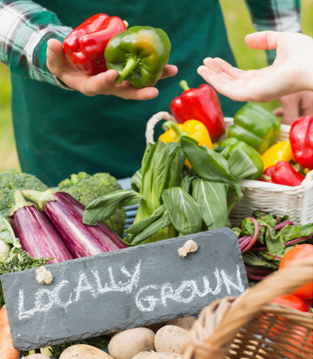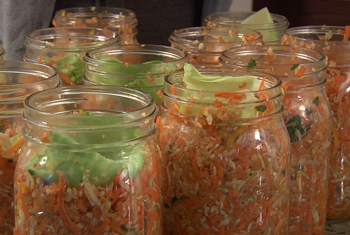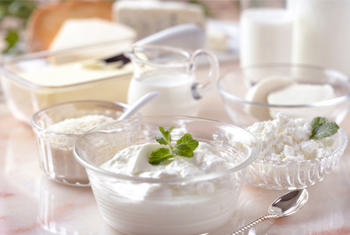"5 Easy Steps to Create Your Own Fermented Foods at Home"
Enjoyed by ancient cultures for centuries… from Rome… to India… to the Ukraine, now you can benefit.*
History provides us a few clues on how different cultures supported their intestinal health before modern times. Years ago, people used fermented foods like yogurt and sauerkraut as food preservatives and as support for intestinal and their health.
Preparing cultured foods and beverages dates back to a time when people didn't have advanced preservation methods available.
Here are a few examples of how pre-modern diverse cultures enjoyed fermented foods (many still do today):
- During Roman times – People enjoyed sauerkraut because of its taste.
- In ancient Indian society – It became commonplace (and still is) to savor a before-dinner yogurt drink called lassi.
- Bulgarians – Are known for their high consumption of fermented milk and kefir.
- In Asian cultures – Pickled fermentations of cabbage, turnips, eggplant, cucumbers, onions, squash, and carrots are still practiced today.
- People of the Ukraine – Consumed foods like sauerkraut, raw yogurt, and buttermilk.
The interesting thing was most of these dietary habits were born from tradition. At the time the tradition began, no one probably knew or understood why they were so good for your digestive system.*
A Great Way to Use a Probiotic Supplement

When it comes to a probiotic supplement, I recommend you use it more as a convenience when you're traveling, or maybe when you're dining out.
I prefer to get probiotics into my system by consuming fermented vegetables.
Several ounces of fermented veggies (prepared with the Mercola recipe below, which utilizes a starter culture) can contain as many beneficial bacteria as a full bottle of a probiotic supplement… an entire bottle!!!
To get a supply of fermented vegetables, you can…
- Purchase them at some local farmers' markets
- Pick them up at many health food stores
- Obtain them through online sources on the internet …But they can be expensive, and you typically won't find them at your local grocery store.
That's why I strongly recommend you consider making your own, not only to save money but to ensure the quality. However, you'll need to put the time in if you want to learn how to make them and garner the benefits.* I'll have more coming up on how to make your own fermented veggies, but first I think it's important for you to know a bit more about the fermentation process itself…
Vegetable Fermentation 101
Mother Nature is pretty smart and often very kind to us. "She" populated nearly all organic fruits and vegetables, the dust covering soil, and all plant matter with Lactobacilli (lacto-fermenting bacteria). Fresh organic cabbage leaves, for example, are covered in Lactobacilli.
Here's an example of the basic fermentation process using organic cabbage as your veggie of choice:
- Chop up the cabbage leaves. If you are not using a starter culture than most recipes suggest, you use salt but that is unnecessary with a starter culture
- As the Lactobacillus start multiplying, they produce lactic acid. That's why they're called Lactobacillus
- As the lactic acid starts producing, it will help preserve the food (cabbage in this case)
However, it's important to know that fermentation does more than simply preserve the food. It can also make nutrients inside the food more bioavailable. I believe this is one of the most important benefits of the entire fermentation process.
Using cabbage again, here's more on the advantages of fermentation:
- The vitamin C in sauerkraut (fermented cabbage) is about six times higher than in the same helping of unfermented cabbage approximately one week after fermentation begins. This is because vitamin C is no longer bound in the cellulose structure after fermenting.
- The vitamin C shortfall with unfermented cabbage is due to the fact that vitamin C is bound in the cellulose structure and various other molecules. Your digestive system is simply not able to "slice" it off and absorb it as well.
Other vitamins, such as K2, can be optimized with specific bacteria strains from fermented vegetables. Again, I believe this is the area that, in addition to helping to preserve the food, is the most important aspect of fermentation.
The Many Varieties of Fermented Foods You Can Choose From

Ideally, you'll want to include a variety of cultured (fermented) foods and beverages in your diet. Each food can help supply your gut with a variety of beneficial microorganisms. Here are some examples of fermented foods you can quite easily make in your own kitchen:
- Cultured vegetables
- Chutneys
- Cultured dairy, such as yogurt, kefir, and sour cream
- Fish, such as mackerel and Swedish graviax
Fermented foods can help support your health because they…
- Can provide higher concentrations of certain nutrients than unfermented foods
- Contain natural levels of prebiotics, which may help to stimulate beneficial microflora growth in your gut
And when it comes to fermenting your own foods, I think a very rewarding place to start is with vegetables…
Save Money and More When You Make Your Own
I was first inspired to grow my own fermented vegetables back in 2011. At the time, I had the opportunity to enjoy some fermented vegetables at an event I was attending.
I was pretty much hooked and immediately started incorporating them into my own diet. And now for the past two years, we have been making fermented veggies in our office kitchen for all employees to enjoy. In addition to the potential health benefits, the good news with fermenting your own veggies is it…*
- Helps you save money from commercial offerings – Presents a great opportunity to save your hard-earned cash. Some fermented veggies can cost more than $20 a quart. You can do it yourself for a tiny fraction of that cost.
- Allows you to customize the fermentation recipe to your individual taste – Unleashes your creativity and imagination to get the preferred taste you want.
- Gives you the satisfaction of doing it yourself – Adds to the creative process and your feeling of accomplishment. Plus, doing it yourself is simply fun.
- Presents a potential business opportunity – Could become a small part-time business venture for you to sell to friends, local health food stores, and perhaps even online (presuming you meet all legal requirements for doing so).
Fermented Vegetables Are Safe to Eat

If you've never experienced and enjoyed fermented vegetables before, you might be concerned about how safe they are to eat. As you already know, people have been consuming fermented foods for centuries. And, I can tell you that I've been eating fermented vegetables (and other cultured foods) for years with positive results.
The fermentation process helps inhibit the growth of unwanted microorganisms.
If you're ready to put a small amount of effort in to reap the benefits of fermented vegetables, here are…
5 Easy Steps to Make Your Own Cultured Veggies
Fermenting veggies is not as time-consuming as you may think. Here are the five basic steps involved in the process:
- Select your vegetables and herbs – The first step is to select firm vegetable (preferably organic) you want to shred to make your blend. Cabbage should be the backbone of your blend.
- Create your brine – It actually is not brine as no salt is used or required. I recommend to get celery juice, use a juicer like my Juice Extractor. This Celery juice contains natural potassium and eliminates the need for additional salt. One quart of celery juice is adequate for 10 to 14 quarts of fermented veggies. Add ¼ teaspoon (1 g) of Kinetic Culture for every quart of vegetables you have.
- Pack the jars – Once you have your shredded veggies and brine mixture combined in a large bowl, tightly pack the mixture into each Mason jar. Compress the mixture using a masher to remove any air pockets and top it off with a cabbage leaf, tucking it down the sides to help ensure your vegetables stay under the brine. Put the jar lids on loosely as the jars will expand during fermentation due to gases produced. Putting the lids on too tightly can cause the jar to crack or explode.
- Ferment the veggies – Allow the jars to sit in a relatively warm place for several days (ideally around 72° Fahrenheit or 23° Celsius). During the summer, veggies are typically done in three to four days. In the winter, they may need up to seven days to ferment. In the end, your "taste" test becomes the deciding factor.
- Store and enjoy – Once you're happy with the flavor, move the veggies to your refrigerator. This slows down further fermentation and will help keep the veggies for two to six months but the longer you wait to use the less crisp the vegetables will be. A refrigerated temperature of around 38° F will help lock in the flavor, texture, and tartness.
Fermenting vegetables is like most everything else that you try for the first time. Once you figure out how to do it, you'll naturally start streamlining the process and cut the total time down to a minimum.
It would be easy for you to miss the small item I mentioned in the "create your brine" step above. And often times, people who ferment veggies at home leave this important step out… or simply don't know about it. I'm talking about using a starter culture…
Added Benefits When You Use This 'Art' to Help the Science
As you already know, there's a great deal of science involved in fermentation. Some people even find all the details quite fascinating on how Mother Nature provides us such a gift.
Well, what I discovered is that along with the science there's a bit of art involved as well. There's a way you can actually help deliver more consistent results… and that's using a starter culture in the process.
Years ago, most people just employed what is called "wild fermentation." Wild fermentation simply uses the native bacteria that are present on the vegetables to culture the food. And that's okay, but doing it the "wild" way tends to be lengthy and the results aren't always consistent.
With the advent of starter cultures, the fermentation process has improved quite a bit. And today, most commercial fermented vegetables are produced using some sort of starter culture.
In a nutshell, here's why I feel using a starter culture is such a key element when fermenting your own veggies:
- Saves you time – Wild fermentation can take up to several weeks. Using a starter culture can cut the time down.
- Yields more consistent results – By adding the "art" of the starter culture, you can help the science of fermentation be more consistent.
- Helps introduce specific nutrients – By including selective strains of bacteria in the starter culture, you can increase the levels of certain nutrients and vitamins may become more bioavailable to you.
But the challenge arises because there are several varieties of starter cultures to choose from. It can be a bit of a "mine field" to walk through when it comes to their quality.
Why I Believe This Starter Culture Is So Exceptional
Not only do I recommend using a starter culture when fermenting your own vegetables, I can't stress enough the importance of using one of high quality.
This may be difficult to determine because there is such a wide variety available. And often times, you won't really know how well a starter culture works until you actually try it. Well, I decided to take most of your guess work out of finding a high-quality starter culture. That's why I created my own starter culture – Kinetic Culture. Plus, this one, called Kinetic Culture goes beyond most of the other starters I've seen available.
So, what makes Kinetic Culture so special?
Well, there are many features of this culture starter that add to its uniqueness. But there's one feature that I believe clearly helps it stand out in the crowd… and that has to do with vitamin K2.
Vitamin K2 is not to be confused with vitamin K1, which is available in leafy green vegetables. K2 is a product of bacterial fermentation that you do produce in your gut and that is present in fermented vegetables and fermented dairy like cheeses, kefir and yogurt, but I believe not nearly enough.
And unfortunately…
- Not all fermented vegetables are high in vitamin K2
- Levels of K2 in cultured veggies depend on specific bacterial strains that have the K2-producing capabilities
- If these specific strains are not present on the vegetables or in the starter culture you use, you could end up with low K2 levels
With Kinetic Culture, I've made sure the right probiotic strains are there to help produce ample amounts of K2 in the recipe I mentioned above… this is truly a unique starter culture. When we tested the recipe mentioned above, we found the levels of vitamin K2 slowly degraded over time. So it is best to consume your fermented vegetables sooner than later.
I'll review with you more details why I feel Kinetic Culture is so special, but first it's important to understand why vitamin K2 can be so important to your overall health…
Remarkable 'Unappreciated' Benefits of K2
If you're not eating vitamin K2-rich fermented foods like cheeses, homemade yogurts, kefirs, or natto, then you might want to consider taking a high-quality vitamin K2 supplement.
Even though it can be a bit pricey, taking a vitamin K2 supplement can be helpful. But I prefer to get vitamin K2 from fermented veggies that are high in K2.
Here are a few of the potential health benefits from vitamin K2:*

- Helps build strong bones and keep them healthy*
- Provides support to your vascular (arteries and veins) system*
- Supports heart health*
- Helps protect your cells against oxidative damage*
- Supports your immune system*
I felt it was important to add just the right probiotic strains to the Kinetic Culture to help boost the levels of K2.
But I can tell you this was not something that happened magically overnight…
Several Years of 'Pain' to Perfect Just What I Wanted in a Starter Culture
Wild fermentation will produce about 90% less K2 than when you use Kinetic Culture as your starter culture in the recipe I provided above. To me, it's a no brainer to take this approach if you want consistent high-quality results and vitamin K2 in your fermented veggies.
I developed Kinetic Culture because when I tested and analyzed how much K2 was in our initial ferments in 2011, I was disappointed. Results from the lab found K2 levels to be quite low.
Well, just like I've been telling you how you need to put the time and effort into certain things in life to reap the benefits, such was the case with my starter culture.*
Here are the basic steps my team and I went through over several years. We…
- Worked with leading microbiologists to develop a special starter culture to produce high levels of vitamin K2
- Achieved a vitamin K2 level in the starter culture that was over 10 TIMES the amount of K2 present in our initial ferments
- Further refined the process by using DNA sequencing analysis to identify and quantify the precise strains that were helpful and beneficial
Normally, the type of DNA sequencing tests we ran would have cost hundreds of thousands of dollars a few years ago. But thanks to the exponential growth of 21st century technology, we were able to conduct these tests at a small fraction of the price.
If you're one of the many people who have been waiting for this type of starter culture, I realize it has taken a few years to produce. But I promise you it is well worth the wait.
Seems Like a No Brainer
Now you may be thinking… "I don't have time for this." But if you watched the video in which my staff member demonstrated how quickly you can prepare fermented vegetables, you saw just how easy it is to do yourself.
It does take some prep time. But remember, this is a small sacrifice to reap all the benefits associated with fermented vegetables.* I cannot state enough how important your gut flora is to your optimal health. Making your own fermented veggies is a fantastic way to help nourish your gut.
And when you add in the phenomenal starter, Kinetic Culture, you've got just what you need to save time by making the process efficient and the results consistent.
Plus, you can save money over the cost of other commercial products. Based on our office experience, the estimated cost to make fermented veggies with Kinetic Culture is around $6 per quart. If you order fermented veggies online, it may cost as much as $25 per quart (including shipping). So, you could see unbelievable savings close to $20 for every quart you have fun making yourself.
If you go through more than a quart of this every week like I do, those savings can add up quickly.
Order your Kinetic Culture today and get started enjoying your own fermented vegetables created to your special personalized taste.
No comments:
Post a Comment